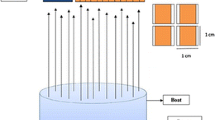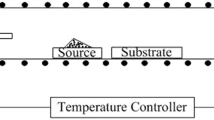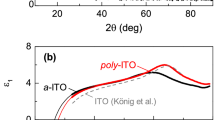Abstract
Highly transparent (over 90% transmission in the visible range) and highly conductive (resistivity ≈2 × 10-4 ohm-cm) indium oxide (undoped) films have been produced by thermal evaporation from In2O3 + In source in a vacuum chamber con-taining low pressures of O2, . Film properties are comparable or superior to the best tin-doped indium oxide films that have ever been reported, and excellent reproducibility has been achieved. Hall effect measurements have revealed that the observed low resistivity is primarily a result of the excellent electron mobility (≏ 70 cm2/V-sec), although the electron concentration is also rather high (≥4 × l020/cm3). X-ray diffraction measurements show distinctly polycrystal-line In2O3 structure with a lattice constant ranging from 10.07Å to 10.11Å. Electrolytic electroreflectance spectra exhibit at least four critical transitions, from which we have determined the direct and indirect optical band gaps (3.56eV and 2.69eV, respectively). Burstein shifts due to the population of electrons in the condition band are also observed. From an internal photoemission study, the work function of the In2O3 film has been determined to be 5.0eV. These and other results, along with a discussion of the processing details are reported.
Similar content being viewed by others
References
R.L. Weiher and R.P. Ley, J. Appl. Phys.37, 299 (1966)
H.K. Muller, Phys. Stat. Sol.27, 723 (1968).
D.B. Fraser and H.D. Cook, J. Electrochem. Soc.119 1368 (1972).
W.W. Molzen, J. Vac. Sci. Technol.12, 99 (1975).
J.C.C. Fan, F.J. Bachner, and G.H. Foley, Appl. Phys. Lett.31, 773 (1977).
W.G. Haines and R.H. Bube, J. Appl. Phys.49, 304 (1978).
R. Groth, Phys. Stat. Sol.14, 69 (1966).
R. Clanget, Appl. Phys.2, 247 (1973).
H. Kostlin, R. Jost, and W. Lems, Phys. Stat. Sol.29 87 (1975).
M. Cardona,Modulation Spectroscopy, Academic Press, New York, 1969.
D.E. Aspnes, Surface Science,37, 418 (1973).
R. Williams, Phys. Rev.117, 1487 (1960).
K.L. Shaklee, F.H. Pollak, and M. Cardona, Phys. Rev. Letts.,15, 883 (1965).
G. Rupprecht, Z. Physik.139, 504 (1954).
V.M. Vainshtein and V.l. Fistul, Soviet Phy.-Semicond.,1 104 (1967).
E. Burstein, Phys. Rev.93, 632 (1954).
L.K. Frevel, J. Appl. Phys.13, 109 (1942).
R.W.G. Wyckoff,Crystal Structures, Vol. 2, 2nd Ed., p.5, Interscience Publisher, NY (1964).
R. Williams, Phys. Rev.,140, A569 (1965).
A.M. Goodman and J.J. O'Neill, Jr., J. Appl. Phys.37_, 3580 (1966).
B.E. Deal, E.H. Snow, and C.A. Mead, J. Phys. Chem. Solids,27, 1873 (1966).
A.M. Goodman, Phys. Rev.144, 588 (1966).
J.C. Reviere, Proc. Phys. Soc. Lond.B70, 676 (1957).
S.W. Lai, L. Franz, G. Grant, R.L. Anderson, J.K. Clif- ton and J.V. Masi, in s'11th IEEE Photovoltaic Spec. Conf.,s' p.398, IEEE, Scottsdale, 12 Aug. (1975).
E.Y. Wang and L. Hsu, J. Electrochem. Soc.125, 1328 (1978).
R. Singh, J. Shewchun, Appl. Phys. Lett.,33. 601 (1978).
R. Singh, J. Electrochem. Soc.126, 1081 (1979).
R. Singh, K. Rajkanan, D. Brodie, and J. Morgan, IEEE Trans. Electron Dev.ED-27, 656 (1980).
J. Shewchun, D. Burk, and M.B. Spitzer, IEEE Trans. Electron Dev.ED-27, 705 (1980).
Author information
Authors and Affiliations
Rights and permissions
About this article
Cite this article
Pan, C.A., Ma, T.P. Highly transparent conductive films of thermally evaporated In2O3 . J. Electron. Mater. 10, 43–57 (1981). https://doi.org/10.1007/BF02654901
Received:
Issue Date:
DOI: https://doi.org/10.1007/BF02654901




